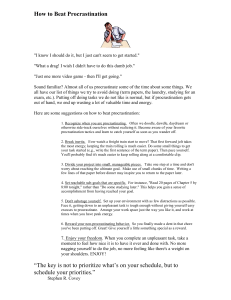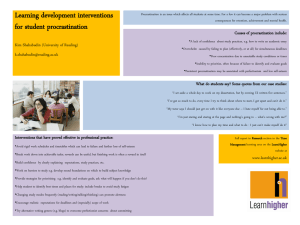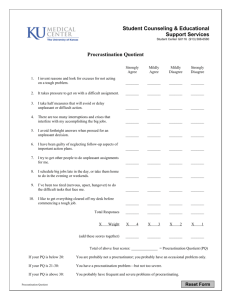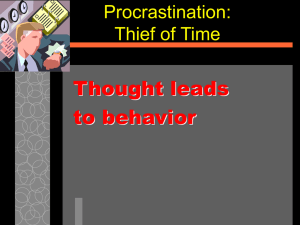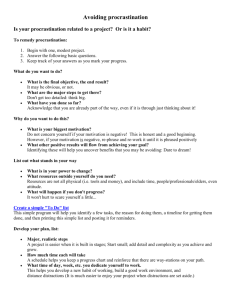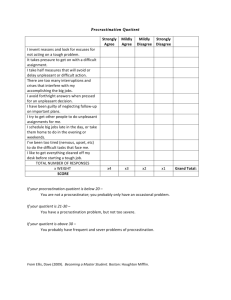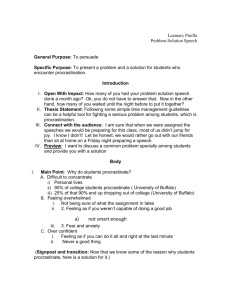The relationship between study skills and academic performance of
advertisement
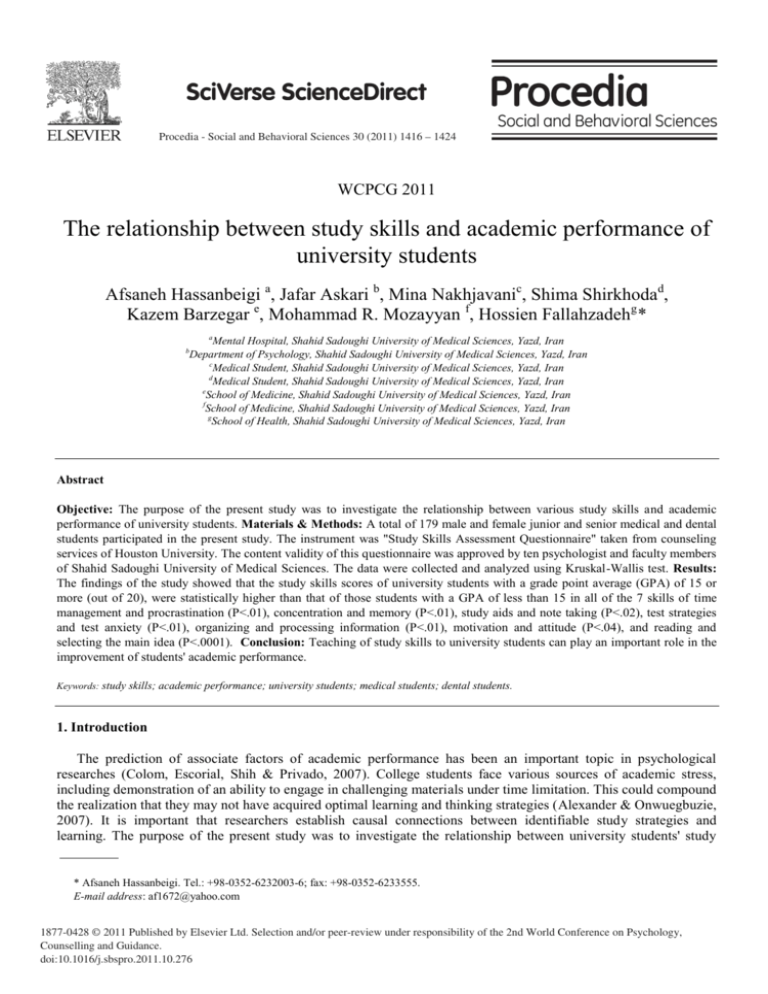
Procedia - Social and Behavioral Sciences 00 (2011) 000–000 Procedia - Social and Behavioral Sciences 30 (2011) 1416 – 1424 Procedia Social and Behavioral Sciences www.elsevier.com/locate/procedia WCPCG 2011 The relationship between study skills and academic performance of university students Afsaneh Hassanbeigi a, Jafar Askari b, Mina Nakhjavanic, Shima Shirkhodad, Kazem Barzegar e, Mohammad R. Mozayyan f, Hossien Fallahzadehg * 1 a Mental Hospital, Shahid Sadoughi University of Medical Sciences, Yazd, Iran Department of Psychology, Shahid Sadoughi University of Medical Sciences, Yazd, Iran c Medical Student, Shahid Sadoughi University of Medical Sciences, Yazd, Iran d Medical Student, Shahid Sadoughi University of Medical Sciences, Yazd, Iran e School of Medicine, Shahid Sadoughi University of Medical Sciences, Yazd, Iran f School of Medicine, Shahid Sadoughi University of Medical Sciences, Yazd, Iran g School of Health, Shahid Sadoughi University of Medical Sciences, Yazd, Iran b Abstract Objective: The purpose of the present study was to investigate the relationship between various study skills and academic performance of university students. Materials & Methods: A total of 179 male and female junior and senior medical and dental students participated in the present study. The instrument was "Study Skills Assessment Questionnaire" taken from counseling services of Houston University. The content validity of this questionnaire was approved by ten psychologist and faculty members of Shahid Sadoughi University of Medical Sciences. The data were collected and analyzed using Kruskal-Wallis test. Results: The findings of the study showed that the study skills scores of university students with a grade point average (GPA) of 15 or more (out of 20), were statistically higher than that of those students with a GPA of less than 15 in all of the 7 skills of time management and procrastination (P<.01), concentration and memory (P<.01), study aids and note taking (P<.02), test strategies and test anxiety (P<.01), organizing and processing information (P<.01), motivation and attitude (P<.04), and reading and selecting the main idea (P<.0001). Conclusion: Teaching of study skills to university students can play an important role in the improvement of students' academic performance. Keywords: study skills; academic performance; university students; medical students; dental students. 1. Introduction The prediction of associate factors of academic performance has been an important topic in psychological researches (Colom, Escorial, Shih & Privado, 2007). College students face various sources of academic stress, including demonstration of an ability to engage in challenging materials under time limitation. This could compound the realization that they may not have acquired optimal learning and thinking strategies (Alexander & Onwuegbuzie, 2007). It is important that researchers establish causal connections between identifiable study strategies and learning. The purpose of the present study was to investigate the relationship between university students' study * Afsaneh Hassanbeigi. Tel.: +98-0352-6232003-6; fax: +98-0352-6233555. E-mail address: af1672@yahoo.com 1877-0428 © 2011 Published by Elsevier Ltd. Selection and/or peer-review under responsibility of the 2nd World Conference on Psychology, Counselling and Guidance. doi:10.1016/j.sbspro.2011.10.276 Afsaneh Hassanbeigi et al. // Procedia – 1424 Afsaneh Hassanbeigi Procedia -–Social Socialand andBehavioral BehavioralSciences Sciences30 00(2011) (2011)1416 000–000 1417 skills and their academic performance. So we intended to compare the effective use of study skills by the university students with a grade point average (GPA) of 15 and more (out of 20) to that of the students with a GPA of less than 15. 1.1. Time Management and Procrastination Time management has been referred to as a set of techniques for managing, planning and appropriate using of time. According Steel (2007) procrastination consists of the intentional delay of an intended course of action, in spite of an awareness of negative outcomes, and according Ferrari, O’Callaghan and Newbegin, (2005) it often results in unsatisfactory performance (Klassen, Krawchuk & Rajani, 2008). Academic procrastination also was defined as leaving academic tasks, such as preparing for exams and doing homework to the last minute and to feel discomfort out of this (Çapan, 2010). Anecdotally, it has been suggested that approximately 95% of all college students procrastinate (Ellis & Knaus, 1977). Other researchers have estimated the prevalence of procrastination among college students to vary between 25% and 50% depending on the type of academic tasks being completed (Solomon & Rothblum, 1984). Furthermore, several studies have found a moderate to strong negative correlation between academic procrastination and academic performance (Van Eerde, 2003). For college students particularly, academic procrastination has been associated with guilt, stress, neuroticism, low self-esteem and low grades (Fritzsche, Young & Hickson, 2003). 1.2. Concentration & Memory One major obstacle to academic achievement is the challenge of shielding academic goal pursuit from unwanted distractions. Because academic success requires continuous striving in the face of distractions (e.g., paying attention in class, completing homework assignments, studying, concentrating during a test), there are numerous opportunities for unwanted distractions to impede academic goal attainment (Parks-Stamm, Gollwitzer & Oettingen, 2010). According to one widely used model, working memory also is an important responsible for the control of attention and processing that is involved in a range of regulatory functions, including the retrieval of information from longterm memory (Baddeley, 2000). Furthermore working memory is composed of multiple components whose coordinated activity is responsible for the temporary storage and manipulation of information (Alloway & Alloway, 2010). It is also related to many of high-level cognitive abilities such as reasoning, problem-solving, and learning (Kyllonen & Christal, 1990). Several researchers found that short-term and working memory predict academic performance to a high degree (Colom, Escorial, Shih & Privado, 2007; Beilock & Carr, 2005). 1.3. Study Aids and Note Taking The pervasive nature of note taking and note reviewing and the assumption that such activities are a necessary part of the college learning experience have encouraged researchers to investigate how students go about taking and reviewing notes and how these activities might be improved (Grabe, 2005). According to Van Meter, Yokoi, and Pressley (1994) college students believe that the act of taking notes facilitates attending to the lecture, comprehension of the material to be learned, and the subsequent recall (Kobayashi, 2005). Slotte and Lonka (1999) found that those who wrote summaries knowing that they could not use them later probably believed that notetaking alone facilitates the process of understanding and organizing the learning material. In the study of Haghverdi, Biria & Karimi, (2010) the results revealed that note-taking strategy instruction had significant effects on the students' achievement. These findings support the view that in academic performance, the process effect of notetaking is of great importance. 1.4. Test Strategies and Test Anxiety Understanding students' emotional experiences during the testing process, in particular test anxiety, has long been a prime concern for researchers, educators and counsellors as test anxiety may have a deleterious impact on test performance, academic success and overall well-being (Bonaccio & Reeve, 2010). In the research of Hunsley 2 1418 Afsaneh Hassanbeigi Hassanbeigi /etProcedia al. / Procedia - Social and Behavioral Sciences 30 (2011) 1416 – 1424 Afsaneh – Social and Behavioral Sciences 00 (2011) 000–000 (1985) results indicated that test anxiety was related to poor test performance both early and late in the term. Chapell et al., (2005) found a significant inverse relationship between test anxiety and grade point average in students. Lowtest-anxious undergraduates averaged a B+, whereas high-test-anxious students averaged a B. 1.5. Organizing & Processing Information For many students, academic challenges are related more to a lack of organization than to a lack of intellectual ability. Students who are disciplined and organized are most likely to be motivated (Komarraju, Karau & Schmeck, 2009). Information processing is also an important factor in academic performance. There are two broad characteristics in information processing. We refer to the first as ‘surface-level processing’, which comprises information-processing strategies such as memorizing, repetition, and analyzing. The second we refer to as ‘deeplevel processing’, and comprises information processing strategies such as relating, structuring, and critical thinking (Rozendaal, Minnaert & Boekaerts, 2003). Inspection of the strategy descriptions in both information-processing modes reveals that conceptually, a sense of regulation is embedded in each information-processing mode. More specifically, students who tend to stick to and memorize the material presented to them by the teacher rely on a form of external regulation. In contrast, students who process knowledge critically by thinking along with authors, teachers, and fellow students, verifying the coherence between the knowledge presented and their prior knowledge (a characteristic of deep-level processing) show initiative and are likely to be more self regulating (Vermunt & Verloop, 1999). 1.6. Motivation and Attitude Motivation is one of the most important psychological concepts in education. It can be classified into intrinsic and extrinsic motivations: Intrinsic motivation refers to doing something because it is inherently interesting or enjoyable, while extrinsic motivation refers to doing something because it leads to a separable outcome (Mizuno et.al., 2008, Deci, Vallerand, Pelletier & Ryan, 1991). Komarraju, et al., (2009) found that academic success is strongly influenced by individual differences in motivation and achievement. 1.7. Reading & Selecting the Main Idea Reading comprehension is a complex cognitive ability requiring the capacity to integrate text information with the knowledge of the listener/reader and resulting in the elaboration of a mental representation (Meneghetti, Carretti & De Beni, 2006). Many believe that early successful reading may set a positive life-course trajectory, leading to good academic and psychosocial outcomes, whereas hampered reading skills may lead to less desirable outcomes (Kern & Friedman, 2009). At college, reading activities are made to comprehend the academic materials and to learn the conceptual framework. In this context, college students can perform an effective reading process by using reading comprehension strategies. Reading comprehension strategies can help readers remember the key points, distinguish the necessary and unnecessary information, think about the main idea and comment on the subject matter (Cogmen & Saracaloglu, 2009). In their strategic discourse processing theory, Van Dijk and Kintsch (1983) differentiated three levels of mental representations that may be constructed during reading: the surface structure for actual words and phrases, the textbase for the semantic content and rhetorical structure, and the situation model, in which the text content has been elaborated by inferences from the reader’s own prior knowledge (Slotte & Lonka, 1999). These different mental representations correspond to different levels of text-processing ranging from a superficial processing to a deeper-level understanding (Lonka, Lindblom-Ylanne & Maury, 1994). According to Taraban, Kerr & Rynearson (2000), students who have upper grades use more reading strategies. 2. Materials and Methods A total of 179 male and female junior and senior medical and dental students (86 males and 93 females) aged 18-25 participated in the present study. Of these, 74 subjects possessed a GPA of 15 and more and 105 subjects possessed 3 1419 Afsaneh Hassanbeigi et al. // Procedia – 1424 Afsaneh Hassanbeigi Procedia -–Social Socialand andBehavioral BehavioralSciences Sciences30 00(2011) (2011)1416 000–000 a GPA of less than 15 (GPA was assessed by self-report on a twenty-point scale that is a traditional method of various educational systems in Iran). The assessment instrument used was "Study Skills Assessment Questionnaire" obtained from counseling services of Houston University. This Questionnaire consists of 7 sections including time management and procrastination, concentration and memory, study aids and note taking, test strategies and test anxiety, organizing and processing information, motivation and attitude, and reading and selecting main idea (note that the writing section has been added to the new version of the questionnaire). Each section of the questionnaire includes 8 items concerning the amount of study skills used by the subjects. Scoring the questionnaire is done using a "Four- Choice Likert Scale". The content validity of this questionnaire was approved by ten psychologist and faculty members of Shahid Sadoughi University of Medical Sciences. The test-retest reliability coefficient of the questionnaire in a two-week interval using a sample of 40 subjects equalled 0.83. Based on the current scientific evidence and the practical needs of students, we believe that the items of the questionnaire correspond greatly to the valid scientific sources and include the main determining factors that influence the students' educational performance. In this research we analyzed the data using "Mann-Whitney Test". 3. Results The findings of the research showed that the scores of students having a GPA of 15 and more in all of the study skills measured were statistically higher than those of the students with a GPA of less than 15 (Table 1). Table 1. Difference in the study skills scores of university students with a GPA of 15 and more compared to those of the students with a GPA of less than 15. Groups GPA of 15 and more GPA of less than 15 M (SD) M (SD) Time Management and Procrastination 18.38 (6.66) 14.28 (6.12) .01 Concentration and Memory 21.54 (5.24) 17.14 (6.06) .01 Study Skills Study Aids and Note Taking Test Strategies and Test Anxiety Organizing and Processing Information Motivation and Attitude Reading and Selecting Main Idea P value 20 (6.56) 14.82 (6.90) .02 18.16 (4.66) 13.86 (4.70) .01 19 (5.24) 14.44 (5.44) .01 16.62 (6.98) 12.14 (7.22) .04 20 (4.58) 14 (6.30) .0001 4. Discussion Based on the research findings, it was observed that for all the study skills measured, students with a GPA of 15 and more scored significantly higher than students with a GPA of less than 15. This result is consistent with the findings of other researches in all of the 7 measured study skills. Regarding the first skill, time management and procrastination, an important key to understanding procrastination may be self-efficacy (Klassen, et al., 2008). Self-efficacy theory (Bandura, 1997) holds that what we believe about ourselves strongly influences our task choice, level of effort, persistence, and resilience, and how we subsequently perform. In academic settings, self-efficacy is a strong predictor of performance (Pajares, 1996) and it has an inverse relationship with procrastination (Steel, 2007, Tuckman, 1991, Wolters, 2003). Ferrari (2001) proposed that procrastination might be considered a ‘‘self-regulation failure of performance’’ in which 4 1420 Afsaneh Hassanbeigi Hassanbeigi /etProcedia al. / Procedia - Social and Behavioral Sciences 30 (2011) 1416 – 1424 Afsaneh – Social and Behavioral Sciences 00 (2011) 000–000 procrastinators fail to regulate their functioning in situations of stress and high cognitive load. Wolters (2003) explored the relationship of procrastination to self-regulated learning and found that metacognitive self-regulation was the second strongest predictor of procrastination after academic self-efficacy beliefs. Self-efficacy for selfregulation is also a strong predictor of the tendency to procrastinate. The costs of academic procrastination are evident: negative procrastinators reported lower GPAs, expected and received a lower class grade, spent more hours procrastinating each day, took longer to begin important assignments, and expressed less confidence that they were capable of regulating their own learning (Klassen, et al., 2008). Viewing procrastination as a coping style, Flett, Blankstein and Martin (1995) found that procrastination correlated positively with avoidance-oriented coping, and concluded that procrastinators seem unwilling or unable to focus on the cause of the problem. This was emphasized by Ferrari, Johnson and McCown (1995) who posited that extreme anxiety is a major discriminative cue for procrastination. More recently, researchers have investigated the importance of hope for educational research and practice (Alexander & Onwuegbuzie, 2007). Indeed, low-hope students appear to use more avoidance coping strategies, when facing stressful academic situations and students’ higher levels of hope have been found to correlate positively with grade point average at the college levels (Chang, 1998). Few studies have described the dynamic, unfolding nature of procrastination across time (Moon & Illingworth, 2005). Schouwenburg and Groenewoud (2001) in their research, hypothesize that procrastination results from what is called the discounting principle or the tendency to discount the value of delayed rewards. For example, studying for an exam may be postponed while the rewards of such behaviour (such as attainment of a good mark and/or avoidance of a poor mark) are distant, and studying may increase in occurrence when rewards become more immediate. To test this hypothesis, they measured students’ estimates of the number of hours they would typically study during each week of a 12-week period leading up to an examination. The relationship between number of weeks prior to the final examination and number of hours that students reported they would study followed a hyperbolic pattern, in which studying rarely occurs far in advance of the examination, and then increases in an accelerating fashion as the examination approaches ( Howell, Watson, Powell & Buro, 2006). Similar findings emerged for students’ judgements of the importance of the examination and their ability to resist social temptation. Some researchers mentioned that personality characteristic of perfectionist is an important cause of procrastination (Çapan, 2010). Perfectionist individuals impose irrationally high standards on themselves and show procrastination because they do not believe that they could meet those standards. Concerning the second skill, concentration and memory, Parks-Stamm, et al., (2010) mentioned that two approaches have been suggested to concentrate and shield goal striving from distraction: ignoring the distraction (i.e., by forming temptation-inhibiting plans) and amplifying the desired behaviour (i.e., by forming task-facilitating plans). Luo, Thompson & Detterman (2006) examined the criterion validity of processing speed and working memory, because both are related to psychometric intelligence. They measured academic performance also. Their results indicated that these basic cognitive processes along with crystallized intelligence account for about 60% of the variability in academic performance (Colom, et al., 2007). The findings that working memory accounted for the largest amount of statistical variance of academic performance, rather than IQ, has valuable implications for education. In the classroom, students frequently need to rely on working memory to perform a range of activities. Poor working memory leads to failures in simple tasks such as remembering classroom instructions to more complex activities that involve storing and processing information and keeping track of progress in difficult tasks (Gathercole, Lamont & Alloway, 2006). Working memory impairments lead to learning deficits as well as difficulty in performing daily classroom activities. One explanation for this is that working memory acts like a bottleneck for learning (Gathercole, Alloway, Willis & Adams, 2006). Because learning is an incremental process, building gradually over time, any disruption such as an inability to retain early learning episodes resulting from poor working memory can jeopardize subsequent learning success (Alloway, & Alloway, 2010). In relation to the third skill, study aids and note taking, one identifiable body of work originated in the descriptive model of DiVesta and Gray (1972) and proposes that students potentially benefit from the process of taking and from the process of reviewing notes (Grabe, 2005). These processes were labelled as the encoding and external storage functions, respectively. The benefits of the encoding function are assumed to result from the cognitive activities involved in generating a personalized written record of the lecture. It has been suggested that students perform better on materials they generate themselves rather than studying materials generated by others (Foos, Mora & Tkacz, 1994). Van Meter et al., (1994) further reported that college students’ own notes were 5 Afsaneh Hassanbeigi et al. // Procedia – 1424 Afsaneh Hassanbeigi Procedia -–Social Socialand andBehavioral BehavioralSciences Sciences30 00(2011) (2011)1416 000–000 1421 personally meaningful to them because these represented their personal selection of important points and were only fully understandable to them as their creators. Typically, students must also contend with the lengthy gap between information presentation and evaluation. The benefit of having an external record to review during this gap is described as the storage function. It is not surprising that the usefulness of lecture notes is very much based on the opportunity to review them later (Slotte & Lonka, 1999). There is some evidence demonstrating the benefit of both the encoding and the storage functions of note taking (Kiewra, et al., 1991). Of course, the modest encoding effect may stem from the interaction between mechanical demands of note-taking and presentation variables such as speed, mode, length, and information density (Kobayashi, 2005). Regarding the fourth skill, test strategies and test anxiety, the cognitive-attentional view of test anxiety (Wine, 1971) may explain the negative role of worry in performance. The view suggests that highly anxious individuals pay more attention to task-irrelevant cues than task-relevant cues, and thus their performance suffers due to their division of attention to both relevant and irrelevant tasks (Hong, 1999). According to several researches, students with inadequate examination-taking coping strategies typically find it difficult to retrieve or to utilize material that they have learned due to experiencing a debilitative affective state (Collins & Onwuegbuzie, 2003). On the other hand results imply that the worry reported by high test-anxious subjects may not simply be a personality characteristic but may rather be due to their inadequate knowledge of the subject matter. Results also imply that programs for helping such subjects should emphasize developing learning strategies and coping techniques for the test situation. In the study of Kirkland & Hollandsworth (1980) it is suggested that the term "test anxiety" be retired and that inadequate test performance be reconceptualised as ineffective test taking. Concerning the fifth skill, organizing and processing information, successful students show a commitment to maximize learning from educational experiences, monitor their progress, and make adjustments in their efforts when necessary to accomplish their goals (Ainley & Patrick, 2006). These study habits are reflected in the student's ability to organize and plan his or her learning. They also involve clarity of purpose and the use of goal-directed actions in the individual's own learning (De la Fuente & Cardelle-Elawar, 2009). Information processing is also the other important factor in this context. Generally, four different types of information processing can be identified among students: the use of mainly surface-level strategies (surface-level processing), the use of mainly deep-level strategies (deep-level processing), no ‘committed’ use of any information-processing strategy (non-academic), and complementary use of the two information-processing modes (strategic processing). According to Entwistle, Koseki & Politt, (1987) ‘strategic’ students can easily adapt their learning strategy to the requirements of a particular task, emphasizing either comprehension learning (deep-level processing strategies) or operation learning (surface-level processing strategies) as appropriate, and using strategies from both information-processing modes in tandem wherever possible or necessary. The findings of Rozendaal et al., (2003) suggested that students who normally performed deep-level processing strategies tended to revert to surface level processing when anxious,( i.e., memorization of notes and texts that were presented to them by the teacher). Generally, in understanding a text a reader is engaged not only in maintaining some piece of information but also, for example, in merging that information with previous knowledge, therefore actively processing incoming information ( Carretti, Borella, Cornoldi & De Beni, 2009). With regard to the sixth skill, motivation and attitude, it has been shown that intrinsic academic motivation (academic achievement motivation) results in better educational outcomes, such as higher academic performances, better quality of learning, increased persistence and effort in studies, and better psychological adjustment of learners, in comparison to extrinsic motivation (Mizuno et.al., 2008). Openness was also positively related with intrinsic motivation, suggesting that students who are intellectually curious are more likely to enjoy learning (Komarraju, et al., 2009). In addition, it has been reported that academic achievement motivation is heightened by academic reward which induce a sense of competence and achievement (Maehr, 1984). Ryan & Deci (2000) believed that externally motivated students can be encouraged to remain motivated and perform well via three options. First, because externally motivated students look for external sources of support, teachers could play an active role by mentoring such students and providing external rewards for hard work. Second, because competent students are more likely to take an intrinsic interest in course activities, training students to develop successful learning strategies may increase their confidence in their abilities. Finally, as students are more likely to internalize actions in contexts that encourage feelings of autonomy and freedom to follow through on plans, providing students with multiple learning and assignment options may also facilitate motivation (Komarraju, et al., 2009). 6 1422 Afsaneh Hassanbeigi Hassanbeigi /etProcedia al. / Procedia - Social and Behavioral Sciences 30 (2011) 1416 – 1424 Afsaneh – Social and Behavioral Sciences 00 (2011) 000–000 Finally, in relation to the seventh skill, reading and selecting main idea, current models of reading comprehension highlight the importance of considering the role of different cognitive processes during text comprehension (Meneghetti, et al., 2006). For example, memory both in its short- and long-term components is broadly considered to have a fundamental role. Indeed, the reader has to store and manipulate information in working memory during the processing of the text, but at the same time in order to construct a coherent representation of the text usually he/she has to refer to his/her prior knowledge (Van Den Broek, 1994). Some strategies like evaluating the comprehension level, inferring the information from the text, anticipating what is coming next, searching for the reading purpose are more analytic and need to have a metacognitive awareness (Cogmen & Saracaloglu, 2009). metacognitive strategies can defined in three ways: planning (have a reading purpose in mind and to read the text in terms of this purpose), self monitoring (to regulate the reading process and use the appropriate strategy at the right time) and self evaluating (the reform phase of the reading process such as; to change strategy if necessary, to control if the purpose is reached and to reread the text). Researchers found out that metacognitive reading strategies usage develops students’ reading comprehension level (Eilers & Pinkley, 2006). According to these researches, not only using strategies increase the academic success but also successful students use strategies while reading. As a result of this, it is critical for a college student to use reading comprehension strategies while reading academic materials for an effective learning (Cogmen & Saracaloglu, 2009). In sum, we need a new conception of teaching and learning by deepening and increasing our understanding of students' individual differences in cognitive characteristics and behavioural strategies. References Ainley, M., & Patrick, L. (2006). Measuring self-regulated learning processes through tracking patterns of student interaction with achievement activities. Educational Psychology Review, 18(3), 267–286. Alexander, E. S., Onwuegbuzie, A. J. (2007). Academic procrastination and the role of hope as a coping strategy. Personality and Individual Differences, 42, 1301–1310. Alloway, T. P. & Alloway, R. G. (2010). Investigating the predictive roles of working memory and IQ in academic attainment. Journal of Experimental Child Psychology, 106, 20–29. Baddeley, A. D. (2000). The episodic buffer: A new component of working memory? Trends in Cognitive Sciences, 4, 417–423. Bandura, A. (1997). Self-efficacy: The exercise of control. New York: W.H. Freeman and Company. Beilock, S. L., & Carr, T. H. (2005). When high-powered people fail: Working memory and “choking under pressure" in math. Psychological Science, 16, 101−105. Bonaccio, S., Reeve, C. L. (2010). The nature and relative importance of students' perceptions of the sources of test anxiety. Learning and Individual Differences, 20, 617–625. Çapan, B. E. (2010). Relationship among perfectionism, academic procrastination and life satisfaction of university students. Procedia Social and Behavioral Sciences, 5, 1665–1671. Carretti, B., Borella, E., Cornoldi, C., & De Beni, R. (2009). Role of working memory in explaining the performance of individuals with specific reading comprehension difficulties: A meta-analysis. Learning and Individual Differences, 19, 246–251. Chang, E. C. (1998). Hope, problem-solving ability, and coping in a college student population: Some implications for theory and practice. Journal of Clinical Psychology, 54, 953–962. Chapell, M. S., Blanding, Z. B., Silverstein, M. E., Takahashi, M., Newman, B., Gubi, A., McCann, N., (2005). Test anxiety and academic performance in undergraduate and graduate students. Journal of educational Psychology, 97(2), 268-274. Cogmen S., & Saracaloglu, A. S. (2009). Students’ usage of reading strategies in the faculty of education. Procedia Social and Behavioral Sciences, 1, 248–251. Collins, K. M. T., Onwuegbuzie, A. J. (2003). Study coping and examination-taking coping strategies: the role of learning modalities among female graduate students. Personality and Individual Differences, 35, 1021–1032. Colom, R., Escorial, S., Shih, P. C. Privado J. (2007). Fluid intelligence, memory span, and temperament difficulties predict academic performance of young adolescents. Personality and Individual Differences, 42, 1503–1514. Deci, E.L., Vallerand, R.J., Pelletier, L.G., Ryan, R.M.,( 1991). Motivation in education: the self-determination perspective. Educational Psychology. 26, 325–346. De La Fuente, J., Cardelle-Elawar, M. (2009). Research on action–emotion style and study habits: Effects of individual differences on learning and academic performance of undergraduate students. Learning and Individual Differences, 19, 567–576. DiVesta, F., & Gray, G. (1972). Listening and note taking. Journal of Educational Psychology, 63, 8–14. Duckworth, A. L., & Seligman, M. E. P. (2005). Self-discipline outdoes IQ in predicting academic performance of adolescence. Psychological Science, 16, 939–944. Eilers, H. L. and Pinkley, C. (2006). Metacognitive strategies help students to comprehend all text. Reading Improvement, 43(1), 13-29. Ellis, A., & Knaus, W. J. (1977). Overcoming procrastination or how to think and act rationally in spite of life’s inevitable hassles. New York, NY: Institute for Rational Living. Entwistle, N., Koseki, B., & Politt, A. (1987). Measuring styles of learning and motivation. European Journal of Psychology of Education, 2, 183–203. 7 Afsaneh Hassanbeigi et al. // Procedia Procedia –- Social – 1424 Afsaneh Hassanbeigi Social and and Behavioral Behavioral Sciences Sciences 30 00 (2011) (2011) 1416 000–000 1423 Ferrari, J. R. (2001). Procrastination as self-regulation failure of performance: Effects of cognitive load, selfawareness, and time limits on working best under pressure. European Journal of Personality, 15, 391–406. Ferrari, J. R., Johnson, J. L., & McCown, W. G. (1995). Procrastination and task avoidance: Theory, research, and treatment. New York: Plenum Press. Ferrari, J. R., O’Callaghan, J., & Newbegin, I. (2005). Prevalence of procrastination in the United States, United Kingdom, and Australia: Arousal and avoidance delays among adults. North American Journal of Psychology, 7, 1–6. Flett, G. L., Blankstein, K. R., & Martin, T. R. (1995). Procrastination, negative self-evaluation, and stress in depression and anxiety: A review and preliminary model. In J. R. Ferrari, J. L. Johnson, & W. G. McCown (Eds.), Procrastination and task avoidance: Theory, research, and treatment (pp. 137–167). New York: Plenum Press. Foos, P. W., Mora, J. J., & Tkacz, S. (1994). Student study techniques and the generation effect. Journal of Educational Psychology, 86, 567– 576. Fritzsche, B. A., Young, B. R., Hickson, K.C. (2003) Individual differences in academic procrastination tendency and writing success. Personality and Individual Differences, 35, 1549–1557. Gathercole, S. E., Alloway, T. P., Willis, C. S., & Adams, A. M. (2006). Working memory in children with reading disabilities. Journal of Experimental Child Psychology, 93, 265–281. Gathercole, S. E., Lamont, E., & Alloway, T. P. (2006). Working memory in the classroom. In S. Pickering (Ed.), Working memory and education (pp. 219–240). Oxford, UK: Elsevier. Grabe, M. (2005). Voluntary use of online lecture notes: correlates of note use and note use as an alternative to class attendance. Computers & Education, 44, 409–421. Haghverdi,H.R., Biria, R.,Karimi, L. (2010). The effect of note-taking strategy instruction on the students' academic achievement. Journal of Asia TEFL, 7(2), 123-151. Hong, E. ( 1999). Test anxiety, perceived test difficulty, and test performance: temporal patterns of their effects. Learning and Individual Differences, 11(4), 431-447. Howell, A. J., Watson. D. C., Powell R. A., Buro K., (2006). Academic procrastination: The pattern and correlates of behavioral postponement Personality and Individual Differences, 40 1519–1530. Hunsley, J. (1985). Test Anxiety, Academic Performance, and Cognitive Appraisals. Journal of Educational Psychology, 77(6), 678-682. Kane, M. J., Brown, L. H., Little, J. C., Silvia, P. J., Myin-Germeys, I., & Kwapil, T. R. (2007). For whom the mind wanders and when: An experience-sampling study of working memory and executive control in daily life. Psychological Science, 18, 614–621. Kern, M. L. Friedman, H. S. (2009). Early educational milestones as predictors of lifelong academic achievement, midlife adjustment, and longevity. Journal of Applied Developmental Psychology, 30, 419–430. Kiewra, K., DuBois, N., Christian, D., McShane, A., Meyerhoffer, M., & Roskelley, D. (1991). Note-taking functions and techniques. Journal of Educational Psychology, 83, 240–245. Kirkland, K. & Hollandsworth, J. G. (1980). Effective test taking: Skills-acquisition versus anxiety-reduction techniques. Journal of Educational Psychology, 48(4), 431-439. Klassen R.M., Krawchuk, L. L., Rajani. S. (2008) Academic procrastination of undergraduates: Low self-efficacy to self-regulate predicts higher levels of procrastination. Contemporary Educational Psychology. 33, 915–931. Kobayashi, K. (2005). What limits the encoding effect of note-taking? A meta-analytic examination. Contemporary Educational Psychology, 30, 242–262. Komarraju, M., Karau, S. J., Schmeck, R. R., (2009). Role of the Big Five personality traits in predicting college students' academic motivation and achievement. Learning and Individual Differences, 19, 47–52. Kyllonen, P. C., & Christal, R. E. (1990). Reasoning ability is little more than working-memory capacity? Intelligence, 14, 389–433. Lonka, K., Lindblom-Ylanne, S., & Maury, S. (1994). The effect of study strategies on learning from text. Learning and Instruction, 4, 253–271. Luo, D., Thompson, L. A., & Detterman, D. K. (2006). The criterion validity of tasks of basic cognitive processes. Intelligence, 34, 79–120. Maehr, M.L.,1984. Meaning and motivation: toward a theory of personal investment. In: Ames, R.E., Ames, C. (Eds.), Research on Motivation in Education (pp. 115–144) New York: Academic Press. Meneghetti, C., Carretti, B., & De Beni, R. (2006). Components of reading comprehension and scholastic achievement. Learning and Individual Differences, 16, 291–301. Mizuno K., Tanaka M., Ishii A., Tanabe H. C., Onoe H., Sadato N., Watanabe Y. (2008). The neural basis of academic achievement motivation. NeuroImage, 42, 369–378. Moon, S. M., & Illingworth, A. J. (2005). Exploring the dynamic nature of procrastination: a latent growth curve analysis of academic procrastination. Personality and Individual Differences, 38, 297–309. Naveh-Benjamin, M., McKeachie, W. J., Lin, Y. G., Holinger, D. P. (1981). Test anxiety: Deficits in information processing. Journal of Educational Psychology, 73(6), 816-824. Pajares, F. (1996). Self-efficacy beliefs in academic settings. Review of Educational Research, 66, 543–578. Parks-Stamm, E. J., Gollwitzer, P.M., Oettingen, G. (2010). Implementation intentions and test anxiety: Shielding academic performance from distraction. Learning and Individual Differences, 20, 30–33. Rozendaal, J.S. Minnaert, A. Boekaerts, M. (2003). Motivation and self-regulated learning in secondary vocational education: informationprocessing type and gender differences. Learning and Individual Differences, 13, 273–289. Ryan, R.M., Deci, E.L., (2000). Intrinsic and extrinsic motivations: classic definitions and new directions. Contemp. Educational Psychology. 25, 54–67. Schouwenburg, H. C., & Groenewoud, J. T. (2001). Study motivation under social temptation: effects of trait procrastination. Personality and Individual Differences, 30, 229–240. Slotte V. & Lonka K. (1999). Review and Process Effects of Spontaneous Note-Taking on Text Comprehension. Contemporary Educational Psychology, 24, 1–20. 8 1424 Afsaneh Hassanbeigi Hassanbeigi /etProcedia al. / Procedia - Social and Behavioral Sciences 30 (2011) 1416 – 1424 Afsaneh – Social and Behavioral Sciences 00 (2011) 000–000 Solomon, L. J., & Rothblum, E. D. (1984). Academic procrastination: Frequency and cognitive-behavioral correlates. Journal of Counseling Psychology, 31, 503–509. Steel, P. (2007). The nature of procrastination: A meta-analytic and theoretical review of quintessential selfregulatory failure. Psychological Bulletin, 133, 65–94. Taraban, R., Kerr, M. and Rynearson, K. (2000). College students’ academic performance and self-reports of comprehension strategy use. Reading Psychology, 21(4), 283-308. Tuckman, B. W. (1991). The development and concurrent validity of the procrastination scale. Educational and Psychological Measurement, 51, 473–480. Van Den Broek, P. (1994). Comprehension and memory for narrative texts: Inferences and coherence. In M. A. Gernsbacher (Ed.), Handbook of psycholinguistics (pp. 539−588). San Diego, CA: Academic Press. Van Dijk, T. A., & Kintsch, W. (1983). Strategies for discourse comprehension. New York: Academic Press. Van Eerde, W. (2003). A meta-analytically derived nomological network of procrastination. Personality and Individual Differences, 35, 1401– 1418. Van Meter, P., Yokoi, L., & Pressley, M. (1994). College students’ theory of note-taking derived from their perceptions of note-taking. Journal of Educational Psychology, 86, 323–338. Vermunt, J., & Verloop, N. (1999). Congruence and friction between teaching and learning. Learning and Instruction, 9, 257–280. Wine, J. D. (1971). Test anxiety and the direction of attention. Psychological Bulletin, 76, 92-104. Wolters, C. A. (2003). Understanding procrastination from a self-regulated learning perspective. Journal of Educational Psychology, 95, 179– 187. 9
